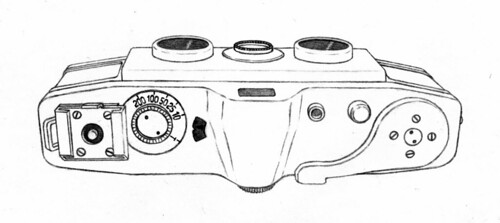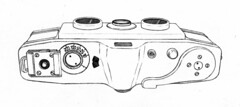CM-16
The CM-16 is a Japanese prototype camera, taking stereo pairs on 16mm film. It was sold at a Japanese online auction in July 2006, and no other document has been found elsewhere.
Manufacturer and name
The auction said that the camera was related to Minolta, and rumour says that it was made by Konan on Minolta specifications. No definitive proof has been found to confirm this.
The camera itself has no marking, except for CM-16 red painted by hand on the bottom plate. This marking might be some internal code for the camera project, but it might also have been applied at a later date.
Description
The camera is shaped as a downsized 35mm stereo camera. The viewfinder is contained in a hump in the middle of the top plate. The two lenses are attached to a chrome-plated rectangular front plate, and have no marking whatsoever. There is a thumbwheel between the two, certainly to set the aperture, but with no visible scale.
The top plate has a film advance lever on the right, together with the shutter release and a hole, certainly to attach a cable release. An exposure counter is visible through a crescent-shaped window on the viewfinder's left. The speed setting wheel is further to the left. It is shaped the same as the aperture wheel, and has indications for 200–10 and T settings. There is a hot shoe and a single strap lug at the left end.

|
| CM-16. (Image rights) |
The back is removable for film loading, together with the bottom plate. It is locked by an almost rectangular key placed underside, with OPEN and CLOSE indications. The tripod thread is somewhat offset to the right, and there are fixed film flanges on both ends of the bottom plate.
Bibliography
The CM-16 is mentioned in no known written source.
